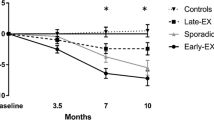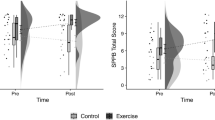Abstract
OBJECTIVE: To determine the time course for changes in aerobic capacity, body weight (BW), and composition in overweight adults in response to a supervised exercise trial with a targeted energy expenditure of 2000 kcal week−1.
DESIGN: The Midwest Exercise Trial (MET) was a randomized, controlled, 16-month verified, supervised exercise trial. Aerobic exercise progressed to 45 min day−1, 5 days week−1 over 6-months and was then maintained for 10 months. Controls maintained their normal physical activity and all participants maintained ad libitum diets.
SUBJECTS: A total of 131 participants were randomized to exercise or control groups and 74 completed the intervention and all laboratory testing.
MEASUREMENTS: At baseline and months 4, 9, 12, and 16, aerobic capacity (VO2max) was measured by indirect calorimetry, BW by digital scale, and fat weight and fat-free weight by hydrostatic weighing.
RESULTS: Aerobic capacity (ml kg−1 min−1) increased (P<0.05) from baseline (39.2±5.2, mean±s.d.) to 9 months (48.8±4.3) in exercising men as well as women (32.8±4.2–39.6±5.5) with no significant changes occurring at 12 or 16 months. From baseline to 9 months BW (94.0±12.6–88.7±9.7 kg) and fat weight (26.8±6.8–21.8±4.5 kg) significantly decreased in exercising men with no changes occurring at 12 or 16 months. There were no changes in fat-free weight across the 16 months for exercising men or for BW or composition in exercising women. Further, there were no significant changes for the control men for aerobic capacity, BW, or body composition across 16 months. Women in the control group showed significant increases in weight of 2.9±5.5 kg and fat weight of 2.1±4.8 kg at 16 months only.
CONCLUSIONS: We recommend that investigations that use exercise without diet as the stimulus for weight loss have at least a 9-month duration to provide sufficient time for the full effects to be realized, should such effects be present.
This is a preview of subscription content, access via your institution
Access options
Subscribe to this journal
Receive 12 print issues and online access
$259.00 per year
only $21.58 per issue
Buy this article
- Purchase on Springer Link
- Instant access to full article PDF
Prices may be subject to local taxes which are calculated during checkout

Similar content being viewed by others
References
Hill JO, Melanson EL . Overview of the determinants of overweight and obesity: current evidence and research issues. Med Sci Sports Exerc 1999; 31 (Suppl): S515–S521.
Hill JO, Peters JC . Environmental contributions to the obesity epidemic. Science 1998; 280: 1371–1374.
Andersson LB . Genes and obesity. Ann Med 1996; 28: 5–7.
Hill JO . Genetic and environmental contributions to obesity. Am J Clin Nutr 1998; 68: 991–992.
Ballor DL, Keesey RE . A meta-analysis of the factors affecting exercise-induced changes in body mass, fat mass and fat-free mass in males and females. Int J Obes Relat Metab Disord 1991; 15: 717–726.
Bouchard C, Rankinen T . Individual differences in response to regular physical activity. Med Sci Sports Exerc 2001; 33 (Suppl): S446–S451.
Garrow JS, Summerbell CD . Meta-analysis: effect of exercise, with or without dieting, on the body composition of overweight subjects. Eur J Clin Nutr 1995; 49: 1–10.
Klesges RC, Eck LH, Mellon MW, Fulliton W, Somes GW, Hanson CL . The accuracy of self-reports of physical activity. Med Sci Sports Exerc 1990; 22: 690–697.
Lichtman SW, Pisarska K, Berman ER, Pestone M, Dowling H, Offenbacher E, Weisel H, Heshka S, Matthews DE, Heymsfield SB . Discrepancy between self-reported and actual caloric intake and exercise in obese subjects. N Engl J Med 1992; 327: 1893–1898.
Forbes GB . Diet and exercise in obese subjects: self-report versus controlled measurements. Nutr Rev 1993; 51: 296–300.
Blair SN, Haskell WL, Ho P, Paffenbarger Jr RS, Vranizan KM, Farquhar JW, Wood PD . Assessment of habitual physical activity by a seven-day recall in a community survey and controlled experiments. Am J Epidemiol 1985; 122: 794–804.
Franklin B, Whaley M, Howley ET, Balady GJ . (Eds) American college of sports medicine guidelines for exercise testing and prescription, 6th edn. Lippincott Williams & Wilkins: Philadelphia; 2000.
Jakicic JM, Clark K, Coleman E, Donnelly JE, Foreyt J, Melanson E, Volek J, Volpe SL . American college of sports medicine position stand. Appropriate intervention strategies for weight loss and prevention of weight regain for adults. Med Sci Sports Exerc 2001; 33: 2145–2156.
Balke B, Ware R . An experimental study of physical fitness of air force personnel. US Armed Forces Med J 1959; 10: 675–688.
Wilmore JH, Vodak PA, Parr RB, Girandola RN, Billing JE . Further simplification of a method for determination of residual lung volume. Med Sci Sports Exerc 1980; 12: 216–218.
Goldman RF, Buskirk ER . Body volume measurement by under-water weighing: description of a method. In: Brozek J, Henschel A (eds). Techniques for measuring body composition. National Academy of Sciences and National Research Council: Bethesda; 1993.
Brozek J, Grande F, Anderson JT, Keys A . Densitometric analysis of body composition: revision of some quantitative assumptions. Ann NY Acad Sci 1963; 110: 113–160.
Drougas HJ, Reed G, Hill JO . Comparison of dietary self-reports with energy expenditure measured using a whole-room indirect calorimeter. J Am Diet Assoc 1992; 92: 1073–1077.
Zuntz H . Determination of non-protein RQ in man. Pflugers Arch Physiology 1901; 83: 557.
USDA. General guidelines for determining food acceptability (procedures for plate waste studies). USDA, Food and Nutrition Service: Washington, DC; 1975.
Gibson RS . Principles of nutrition assessment. Oxford University Press: Oxford; 1990.
Littel RC, Milliken GA, Stroup WW, Wolfinger WD . SAS system for mixed models. SAS Institute Inc: Cary NC; 1996.
McCulloch CE, Searle SR . Generalized, linear, and mixed models. Wiley-Interscience: New York, NY; 2000.
Ballor DL, Poehlman ET . A meta-analysis of the effects of exercise and/or dietary restriction on resting metabolic rate. Eur J Appl Physiol Occup Physiol 1995; 71: 535–542.
National Institutes of Health: National Heart, Lung and Blood Institute. Clinical guidelines on the identification, evaluation and treatment of overweight and obesity in adults—The evidence report. Obes Res 1998; 6(Suppl 2): s51–s212.
Toubro S, Astrup A . Day-today variability of 24-h energy expenditure, respiratory quotient, macronutrient, and physical activity measured in a respiratory chamber. Am J Clin Nutr 1994; 59(Suppl): 775S.
Blaak EE, Westerterp KR, Bar-Or O, Wouters LJ, Saris WH . Total energy expenditure and spontaneous activity in relation to training in obese boys. Am J Clin Nutr 1992; 55: 777–782.
Jakicic JM, Polley BA, Wing RR . Accuracy of self-reported exercise and the relationship with weight loss in overweight women. Med Sci Sports Exerc 1998; 30: 634–638.
Hise ME, Sullivan DK, Jacobsen DJ, Johnson SL, Donnelly JE . Validation of energy intake measurements determined from observer-recorded food records and recall methods compared with the doubly labeled water method in overweight and obese individuals. Am J Clin Nutr 2002; 75: 263–267.
Raison J, Basdevant A, Sitt Y, Guy-Grand B . Regional differences in adipose tissue lipoprotein lipase activity in relation to body fat distribution and menopausal status in obese women. Int J Obes Relat Metab Disord 1988; 12: 465–472.
Schutz Y, Tremblay A . Does lipid oxidation differ in gynoid and android obese women? Int J Obes Relat Metab Disord 1992; 16: 67–69.
Fujioka S, Matsuzawa Y, Tokunaga K, Kawamoto T, Kobatake T, Keno Y, Kotani K, Yoshida S, Tarui S . Improvement of glucose and lipid metabolism associated with selective reduction of intra-abdominal visceral fat in premenopausal women with visceral fat obesity. Int J Obes Relat Metab Disord 1991; 15: 853–859.
Stallone DD, Stunkard AJ, Wadden TA, Foster GD, Boorstein J, Arger P . Weight loss and body fat distribution: a feasibility study using computed tomography. Int J Obes Relat Metab Disord 1991; 15: 775–780.
Leenen R, van der Kooy K, Deurenberg P, Seidell JC, Weststrate JA, Schouten FJ, Hautvast JG . Visceral fat accumulation in obese subjects: relation to energy expenditure and response to weight loss. Am J Physiol 1992; 263 (Part 1): E913–E919.
Wood PD . Clinical applications of diet and physical activity in weight loss. Nutr Rev 1996; 54 (Part 2): S131–S135.
Efendic S . Catecholamines and metabolism of human adipose tissue. 3. comparison between the regulation of lipolysis in omental and subcutaneous adipose tissue. Acta Med Scand 1970; 187: 477–483.
Acknowledgements
We thank the participants who volunteered their time and effort for this study. Additionally, we thank the staffs of the University of Kansas and The University of Colorado Health Sciences Center for their time and expertise. This work was funded by NIH DK 49181 and MO1 RR0051.
Author information
Authors and Affiliations
Corresponding author
Rights and permissions
About this article
Cite this article
Kirk, E., Jacobsen, D., Gibson, C. et al. Time course for changes in aerobic capacity and body composition in overweight men and women in response to long-term exercise: the Midwest Exercise Trial (MET). Int J Obes 27, 912–919 (2003). https://doi.org/10.1038/sj.ijo.0802317
Received:
Revised:
Accepted:
Published:
Issue Date:
DOI: https://doi.org/10.1038/sj.ijo.0802317
Keywords
This article is cited by
-
The application of repeated testing and monoexponential regressions to classify individual cardiorespiratory fitness responses to exercise training
European Journal of Applied Physiology (2019)
-
Interpreting Adaptation to Concurrent Compared with Single-Mode Exercise Training: Some Methodological Considerations
Sports Medicine (2018)
-
Laparoscopic Adjustable Gastric Banding (LAGB) Aftercare Attendance and Attrition
Obesity Surgery (2015)
-
Body Fat Responses to a 1-Year Combined Exercise Training Program in Male Coronary Artery Disease Patients
Obesity (2012)
-
Genetic variation for body weight change in mice in response to physical exercise
BMC Genetics (2009)



